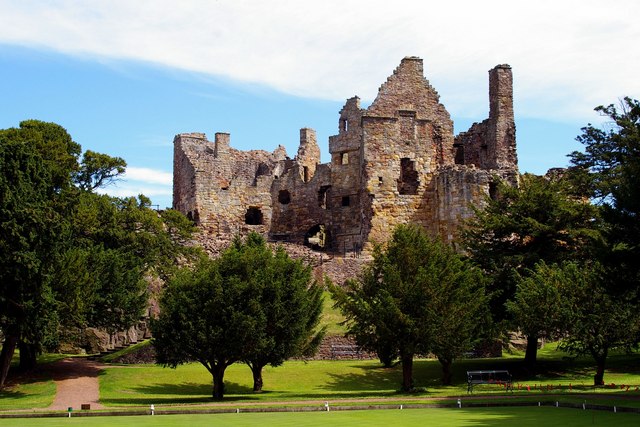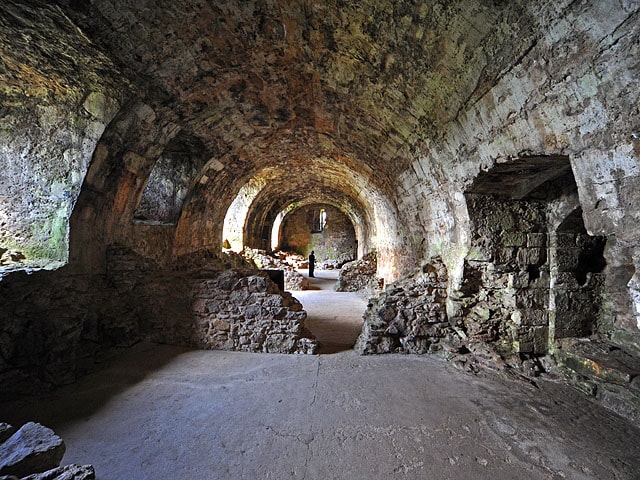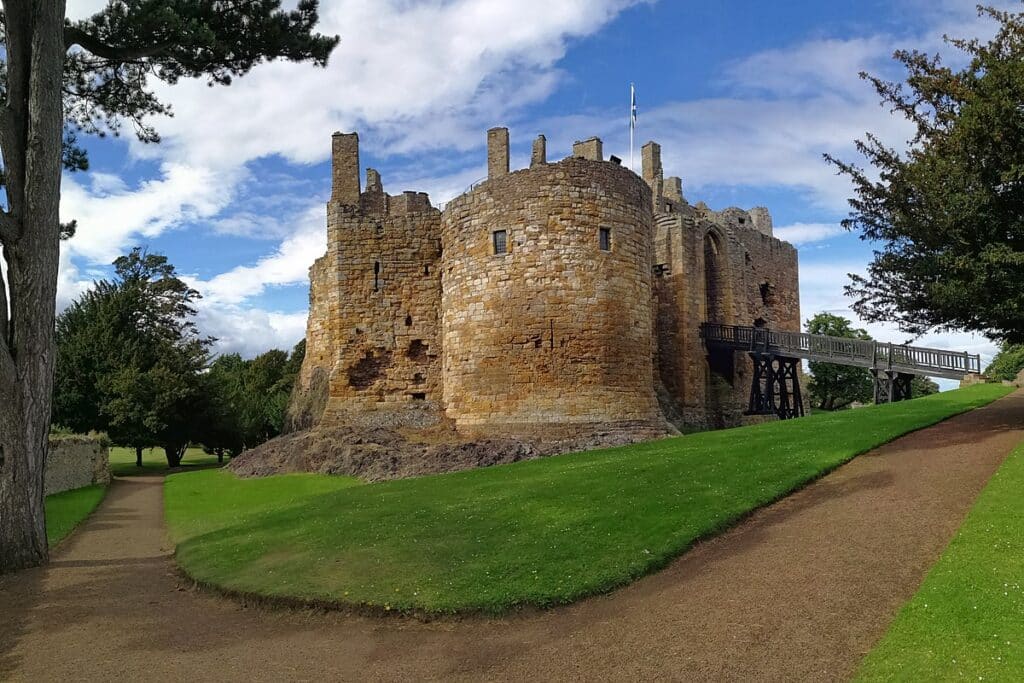Dirleton Castle is an impressive historical attraction located in East Lothian outside of Edinburgh. The fortress and noble residence have been resilient and robust for four Scottish families for 400 years. Throughout the centuries, the Castle has been known for its fantastic collection of Scottish history and the beautiful north garden, but that’s only the tip of the iceberg for Dirleton Castle.
We’ll cover all you need to know about the ruins of this Castle near North Berwick, specifically its fascinating history, details to know, and the top attractions to see while you’re there.
History of Dirleton Castle
Dirleton Castle’s history begins in France if you can believe it. The de Vaux family originated in Northern France but emigrated to England during the Norman Conquest of 1066. Two brothers of the de Vaux family were invited to Scotland by David I of Scotland, and one of the brothers, John de Vaux, was granted to the barony of Dirleton. During a period of relative peace before the Wars of Scottish Independence, Dirleton Castle (or an earlier form of it) was built to represent the power of the de Vaux family but was eventually passed through successive noble families.
Reign of the Haliburton
Throughout the Wars of Scottish Independence, Dirleton Castle changed hands multiple times between the Scottish and English. It was a strategically important location, straddling the border between the two nations. By 1350, the Berwickshire family of Haliburton married into the de Vaux family and soon became the new de facto residents of the Dirleton Castle.
The Castle had been severely damaged during the Wars of Scottish Independence, and so repairs had to be made once Haliburton took over the Castle. Throughout these repairs, Haliburton also added onto the Castle, building a smaller round tower house, heightening the towers of the Castle, a large hall, and committing to a new gatehouse in the southwest.
King James IV was so impressed by the castle grounds that he paid for the masons to upholster and build up the northeast side of the Castle. King James IV also contributed to allocating the keeper of the Castle when Patrick Haliburton died, naming his widow and her brother’s keeper until one of Patrick’s daughters was married.
The Ruthven Lodging
Janet Haliburton, eldest of three daughters to the late Patrick Haliburton, married William Ruthven, so Dirleton Castle and its titles passed onto him and the Ruthven family. William’s son, Patrick, would not be able to take the title of Lord Dirleton as he fled to England after he murdered the private secretary of Mary, Queen of Scots. Dirleton instead went to Patrick’s son, who was called William (slightly confusing, we know), who played a substantial part in Scottish history.
William Ruthven, better known by historians as the Earl of Gowrie, kidnapped the young James VI in a plot known as the Raid of Ruthven. While the young king was seized, the Earl of Gowrie ruled in his place until he was executed in 1584 for his treacherous acts. While the Early was an unsavoury figure, it is in part thanks to him that Dirleton Castle has such renowned gardens! He was an avid horticulturist and planted foliage plants within the gardens.
The Gowries continued to rule at Dirleton Castle until the 1600s when the Cromwell invasions occurred.
Oliver Cromwell Invasion Until Today
During the Third English Civil War, Oliver Cromwell invaded Scotland in 1650 and ordered 1,600 soldiers to capture Dirleton Castle. The militia advanced Dirleton Castle on 10 November with multiple mortals to destroy the inner courtyard and bridge of the Castle. The capture was successful, and unfortunately, the Castle slowly degraded for the rest of the time.
From the late 1600s, John Nisbet took over the Castle and maintained it. The Nisbets maintained the gardens and even added a bowling green. By the 1920s, the north gardens were beautified and resemble what they look like today. In the 1920s, during the Arts and Crafts Movement, long herbaceous borders were added to the Castle that surrounded the gardens.
Around the same time, the Castle was also placed in the care of Historic Scotland and is now managed by Historic Environment Scotland.
How to Get There & Details to Know
Dirleton Castle sits within East Lothian, on the east side of Edinburgh. The visitor access may be restricted to certain parts of the Castle, affecting entry prices. The Castle is open throughout the year, with varying opening times.
During the summer months, between 1 April – 30 September, the Castle is open daily from 9:30 to 17:30, with last entry at 17:00. From 1 October – 31 March, the Castle is open from 10:00 to 16:00m, with last entry at 15:30. Dirleton Castle is closed from 12:30 to 13:30 for lunch.
Adult tickets cost £7.50 (reduced amount £3.80), child tickets cost £4.50 (reduced amount £2.30), and concession tickets cost £6.00 (reduced amount £3.00). There are a variety of family packages that cost anywhere from £15.00 – £25.50 (reduced amounts £7.50 – £13.00).
The Castle may be closed, and guarantee entry is not permitted during extreme weather conditions as a precautionary measure.
How to Get There by Car
Travelling by car to Dirleton Castle from Edinburgh, take the A1 east and then the A198 after Meadowmill. Travel along the A198 to Longniddry and then on the B1377. The B1377 should lead you to the B1345, which takes you to Dirleton Village and Dirleton Road. There is a car park that you can park before the main gate.
How to Get There by Transit
There are options to reach Dirleton Castle from Edinburgh via public transit. Travel to St Andrew’s House from Edinburgh’s city centre and take the North Berwick bus line. Take the bus station 68 stops until you reach the Castle stop. Dirleton Castle is a one-minute walk from the bus stop.
Attractions at Dirleton Castle
Although much of Dirleton Castle is in ruins, with Historic Scotland attempting to restore portions of the Castle to its original state, it is an impeccable historic site to see while you’re exploring the attractions within East Lothian. Here are the interests that this romantic Castle has to offer visitors:
Explore the Victorian Garden

The castle grounds today date back to the 16th and 17th centuries, when the Douglas and Ruthven families lived within the magnificent fortified residence. While the Arts and Crafts Movement created the beautiful north garden with its herbaceous borders, the formal Victorian west garden is filled with an immaculately designed landscape with a number of local and exotic foliage plants to see.
Foliage and flowers aren’t the only attraction with the caste grounds, however, and the gardens boast several other adorable attractions that guests can see if they look hard enough. A beehive-shaped pigeon house, or doocot, is home to over 2,000 pigeons! The Ruthven family built the doocot in the 16th century.
The gardens also contain a small gazebo that has a small museum area, covering the history of the Arts and Crafts Garden and the growth of the castle grounds.
See the World’s Longest Herbaceous Border
That’s right; fragrant, herbaceous borders greet visitors as they arrive at Dirleton Castle. Not just any herbaceous borders either, as Dirleton has the world’s longest herbaceous borders, according to the Guinness Book of World Records!
Take a Tour of the Castle’s Interior

While much of Dirleton Castle remains in ruin, there’s a lot to see on a tour of the Castle’s interior. Here are the top things to look forward to while you’re seeing the Castle and gardens:
Remember that the Castle currently has no visitor access and access restrictions to the Guard House, South Entrance, and De Vaux Range.
The Lord’s Hall
The Lord’s Hall is one of the most prestigious parts of the Castle ruins that visitors can see on their trip to Dirleton Castle. This great hall has several exciting features that you can see, including the remnants of the fireplace.
The Lord’s Hall is extravagant, with high ceilings and window seats that look out to the courtyard. While it’s only a shadow of what it once was, the Lord’s Hall is a great place to visit in Dirleton Castle.
Inner Courtyard
The ground floor of Dirleton Castle connects to the immense inner courtyard, which once contained a bowling green where noble families would spend the day playing various games. The green is surrounded by stunning yew trees, seen from the upper floors of Dirleton Castle.
The courtyards also connect to the outer courtyard, where the original gateway remains.
The Vault
Once you explore the defensive perimeters of Dirleton Castle, which has a murder hole where defenders would pour hot tar and stones onto invaders. You can navigate down to the vaults below the Castle’s ground floor.
The Vault contained the prisoners of the Castle, as well as the black-as-night pit where the absolute worst criminals would be kept.
Try out the Playpark
Within the car park right outside the main residence, there is a play park where the children of visitors can enjoy several fun activities after exploring Dirleton Castle. If you’re looking for a place where your kids can let off some energy before heading to the next attraction within East Lothian, then the playpark is ideal.
More Scottish Castles to Visit
- Aberdour Castle
- Balmoral Castle
- Balvenie Castle
- Blackness Castle
- Blair Castle
- Brodick Castle
- Caerlaverock Castle
- Castle Campbell
- Castle Menzies
- Cawdor Castle
- Corgarff Castle
- Culzean Castle and Country Park
- Doune Castle
- Drumlanrig Castle
- Duart Castle
- Dumbarton Castle
- Dunnottar Castle
- Dunrobin Castle and Gardens
- Dunstaffnage Castle
- Dunvegan Castle
- Edinburgh Castle
- Eilean Donan Castle
- Fyvie Castle
- Glamis Castle
- Huntly Castle
- Inveraray Castle
- Kellie Castle
- Kilchurn Castle
- Lochleven Castle
- Muness Castle
- Ravenscraig Castle
- Scalloway Castle
- St Andrews Castle and Cathedral
- Stirling Castle
- Tantallon Castle
- Thirlestane Castle
- Threave Castle
- Urquhart


